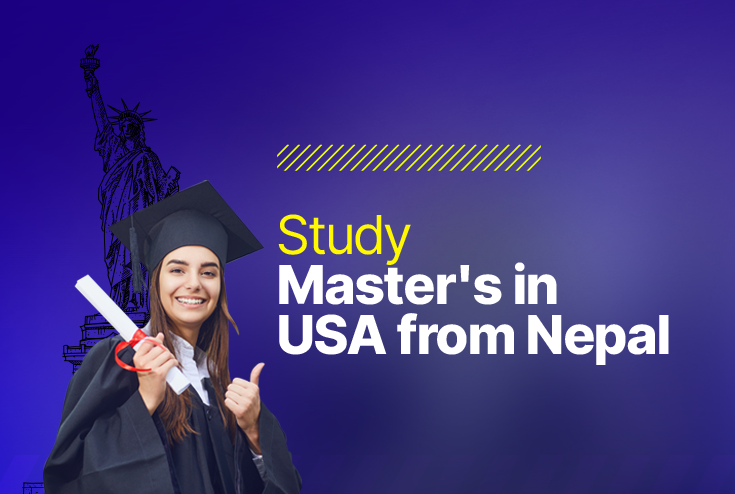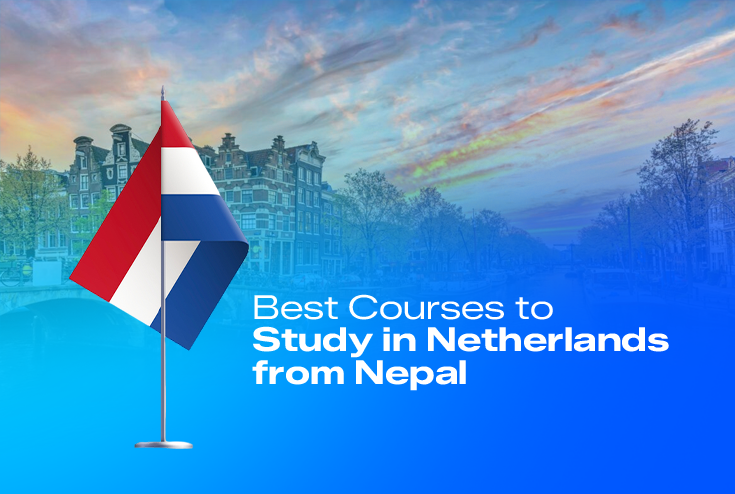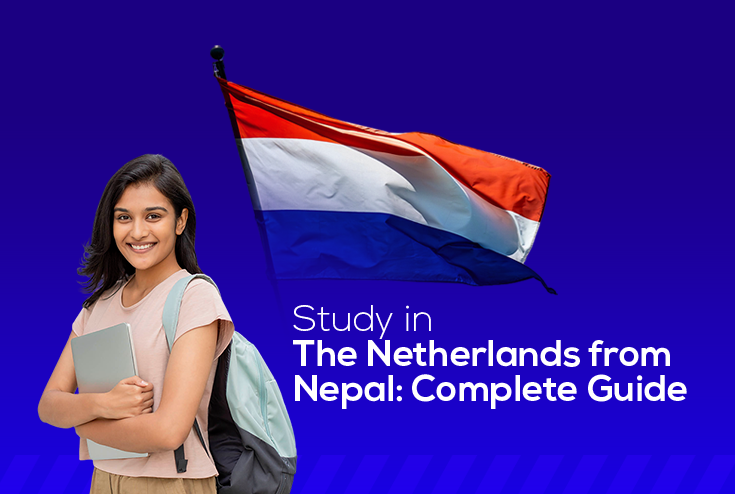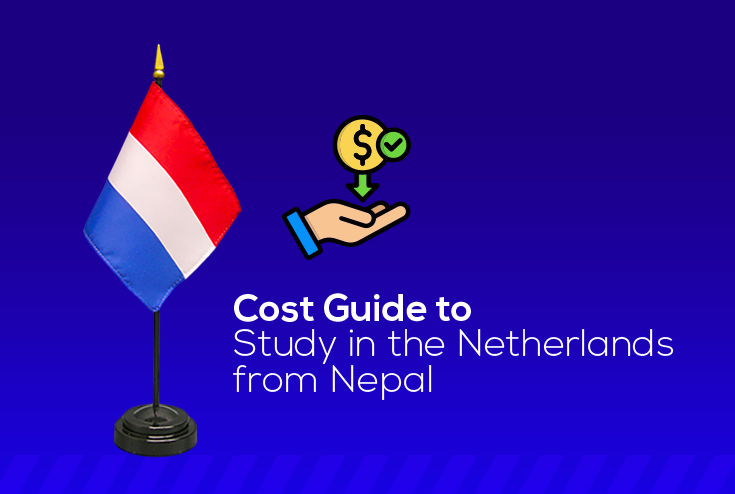
Study Master’s in USA from Nepal: A 2025 Guide
Are you a Nepali student dreaming of pursuing a Master’s degree in the United States? The USA has long been a top destination for higher education, offering world-class universities, research opportunities, and post-study work options.
This guide provides everything you need to know about studying a Master’s in USA from Nepal, from eligibility requirements and application process to scholarships, visa guidance, and post-graduation opportunities.
Table of Contents
- Why Study Master’s in the USA?
- Popular Master’s Programs in USA for Nepali Students
- Eligibility Criteria for Master’s in the USA from Nepal
- 1. Academic Qualifications
- 2. Standardized Test Requirements
- 3. English Language Proficiency
- 4. Required Documents for Admission
- 5. Work Experience (If Required)
- Application Process for the Master’s Degree in the USA from Nepal
- Cost of Studying Master’s Degree in USA from Nepal
- Tuition Fees
- Living Expenses
- Other Costs
- Scholarship Opportunities in the USA for International Students
- University-Specific Scholarships
- Government-Funded Scholarships
- Assistantships & On-Campus Jobs
- How to Increase Scholarship Chances
- Visa Application Process for USA from Nepal
- Documents Required During the F1 Visa Interview in Nepal
- Common Questions During the F1 Visa Interview
- What If a US Visa is Denied?
- Conclusion
- FAQs - Study Master’s in the USA from Nepal
Why Study Master’s in the USA?
Pursuing a Master’s degree in the United States is a dream for many Nepali students and for many good reasons. The USA remains one of the most popular and prestigious destinations for graduate studies globally.
Here’s why studying a Master’s in the USA in 2025 is a smart investment for your academic, professional, and personal growth.
1. World-Class Education System
The US is home to over 50 of the top 100 universities in the world. With cutting-edge facilities, renowned faculty, and a commitment to innovation, students receive an education that is both practical and globally respected.
Highlights:
- Emphasis on critical thinking and innovation.
- Hands-on learning through labs, internships, and research.
- Choice-based credit systems that let you customize your curriculum.
2. Global Recognition & Career Opportunities
A Master’s degree from a US university is highly valued by employers worldwide. Graduating from a recognized American institution can give you a competitive edge whether you choose to work in Nepal, the US, or any other country.
Benefits:
- Recognized qualifications across global job markets.
- Access to large alumni networks and global conferences.
- Strong university-industry collaboration for job placements.
3. Wide Range of Programs & Flexibility
The USA offers thousands of Master’s programs across diverse fields — from STEM and business to arts, healthcare, and social sciences. Universities also allow you to switch specializations, take interdisciplinary courses, and even design your own study tracks.
Example: A student can combine Data Science with Business Analytics or Public Health with Environmental Studies.
4. Scholarships and Financial Support
Despite the high tuition costs, many US universities offer scholarships, assistantships, and grants specifically for international students, including those from Nepal. Programs like Fulbright Nepal, university-specific aid, and need-based grants help reduce the financial burden.
Types of Support:
- Merit-based scholarships
- Research/Teaching Assistantships (RA/TA)
- Graduate Fellowships
- Need-based grants and work-study opportunities
5. Research and Innovation Opportunities
The US is a global leader in research and development. As a Master’s student, you can engage in cutting-edge projects, publish papers, and collaborate with leading researchers in your field. STEM students, in particular, benefit from advanced lab infrastructure and industry-funded research.
Key Areas:
- Artificial Intelligence & Machine Learning
- Biotechnology
- Climate Change & Sustainability
- Cybersecurity
- Public Health
6 Cultural Diversity and Global Exposure
With students from over 150 countries, US campuses are melting pots of culture, ideas, and perspectives. Studying in the USA allows you to expand your worldview, improve your cross-cultural communication, and become truly global in your thinking.
7 Post-Study Work Options (OPT & H-1B)
The USA offers generous post-study work opportunities. After graduation, you can stay back and gain work experience through Optional Practical Training (OPT). If you’re in a STEM field, you can extend your stay up to 3 years under STEM OPT.
Pathway: OPT → STEM OPT (if eligible) → H-1B → Permanent Residency (optional)
8 Strong Support Systems for Nepali Students
Many US universities have active Nepali student associations (NSA), academic advisors, international student offices, and counseling services. These resources help students adjust smoothly and succeed academically and socially.
Support Includes:
- Visa & immigration assistance
- Career counseling & internships
- Mental health support
- On-campus employment guidance
Popular Master’s Programs in USA for Nepali Students
Choosing the right Master’s program is crucial for aligning your academic background with your career goals. Nepali students in 2025 are increasingly selecting career-focused and globally relevant programs that offer post-study work opportunities, research potential, and a clear path to skilled employment.
Below is a detailed look at the most popular Master’s programs in the USA for students from Nepal:
- MS in Computer Science
- MS in Data Science / AI / Machine Learning
- Master of Public Health (MPH)
- MS in Engineering (Electrical, Civil, Mechanical)
- Master of Business Administration (MBA)
- MS in Environmental Science
- MS in Agriculture or Sustainable Development
- MS in Social Work or International Development
Eligibility Criteria for Master’s in the USA from Nepal
To pursue a Master’s degree in the United States, Nepali students must fulfill both academic and standardized requirements, along with language proficiency and visa-related criteria. These requirements can vary slightly by program or university, but here’s a comprehensive overview of the general eligibility criteria in 2025.
1. Academic Qualifications
- Bachelor’s Degree: You must have completed a 4-year Bachelor’s degree or a 3-year Bachelor’s + 1-year PG Diploma (some universities accept 3-year degrees if they meet their equivalency).
- Minimum GPA: Most universities require a minimum GPA of 2.75 to 3.0 on a 4.0 scale (equivalent to 60–70% in Nepal).
Top-tier universities may require a GPA of 3.5+ or distinction (75%+).
2. Standardized Test Requirements
a) GRE (Graduate Record Examination)
- Required for: MS, STEM, Psychology, and some Social Sciences programs.
- Minimum Score:
- Verbal Reasoning: 150+
- Quantitative Reasoning: 155+
- AWA (Essay): 3.0+
Note: Many universities have made some tests optional post-COVID, but they still add value to competitive applications.
b) GMAT (Graduate Management Admission Test)
- Required for: MBA and some MS in Business/Management programs
- Minimum Score:
- 550+ for competitive programs
- 600–700+ for top business schools like Wharton, MIT, or Harvard
3. English Language Proficiency
a) TOEFL (Test of English as a Foreign Language)
- Minimum Score:
- Overall: 80–100 (iBT)
- Some universities may accept 70+ with conditional admission
b) IELTS (International English Language Testing System)
- Minimum Score:
- Overall Band: 6.5
- No band less than: 6.0 (varies by program)
c) Duolingo English Test
- Accepted by 2000+ US universities in 2025
- Minimum Score:
- 105–120 (varies by institution)
- Cheaper and faster alternative to TOEFL/IELTS
Even if you’ve studied in English medium, you still need to prove English proficiency for a student visa unless exempted by your university.
4. Required Documents for Admission
Most universities require the following:
- Academic Transcripts (Bachelor’s degree and SLC/+2 if requested)
- Degree Certificates and Mark Sheets
- Statement of Purpose (SOP) – A well-written SOP is crucial
- Letters of Recommendation (LORs) – Usually 2-3 from academic/professional referees
- Updated CV/Resume – Including academic projects, work experience, and skills
- Passport Copy (Valid for at least 6 months or more)
- Test Scores – GRE/GMAT, TOEFL/IELTS
- Application Fee – Ranges from $50 to $120 depending on university
5. Work Experience (If Required)
- Not mandatory for most MS programs.
- For MBA, MPA, or Master of Social Work, 2–3 years of professional experience may be preferred or required.
- Research programs may also prefer students with prior internship or academic research exposure.
Application Process for the Master’s Degree in the USA from Nepal
The application process to study a Master’s degree in the USA may seem complex at first, but by breaking it down into clear steps, you can navigate it smoothly. Here’s a step-by-step guide tailored for you:
Step 1: Research and Shortlist Universities (6–12 Months Before Intake)
Start early! Decide your intake season:
- Fall (August/September) – Most preferred
- Spring (January) – Limited options
- Summer (May) – Very few universities
What you need to do:
- Identify universities offering your preferred course
- Check program curriculum, faculty, tuition fees, scholarships Look for STEM designation (important for longer OPT)
Use tools like:
- US News Rankings
- QS World University Rankings
- Respective University websites
Step 2: Prepare for Standardized Tests (3–6 Months Before Applications)
Depending on your program, prepare for:
- GRE/GMAT (if required)
- TOEFL/IELTS/Duolingo English Test for English proficiency
Step 3: Gather Required Documents
Start collecting the essential application materials as listed above.
Step 4: Apply to Universities (3–6 Months Before Intake)
Applications are usually submitted online via the university’s portal. Some universities also use centralized portals like Common App, ApplyWeb, or Slate.
What to Do:
- Create a checklist of deadlines
- Pay application fees (usually $50–$120 per university)
- Upload all required documents
- Track your application via the portal
Step 5: Apply for Scholarships and Financial Aid
Start applying for scholarships after submitting your applications.
Look for:
- Merit-based scholarships
- Graduate Assistantships (GA/RA/TA)
- External Scholarships like: Fulbright Nepal
Many universities automatically consider students for merit aid. Check each university’s financial aid office for deadlines.
Step 6: Attend Interviews (If Required)
Some competitive programs (especially MBA or MS in Public Policy) may schedule interviews via Zoom or phone. Be confident, honest, and know your SOP.
Practice common questions like:
- Why this program?
- What are your career goals?
- Why study in the USA?
Step 7: Receive Admission Offers
You’ll receive an email notification and can check the portal for admission decisions. You’ll need to accept the admission offer.
Step 8: Receive I-20 Form
Once you accept admission:
- Submit proof of funds (bank statements, sponsor letters)
- The university issues Form I-20, a crucial document for visa application
- You must show around $25,000 to $60,000 in bank balance depending on your university and location.
Cost of Studying Master’s Degree in USA from Nepal
Studying for a Master’s degree in the USA is a significant investment, but understanding the breakdown of expenses can help you plan better and seek the right financial aid.
Here's a detailed overview of the cost of studying in the USA from Nepal in 2025:
Tuition Fees
The tuition cost largely depends on the type of university and field of study.
|
University Type |
Annual Tuition Fees (USD) |
Equivalent in NPR (Approx.) |
|---|---|---|
|
Public Universities (State) |
$15,000 - $25,000 |
NPR 2,000,000 – 3,300,000 |
|
Private Universities |
$25,000 - $50,000 |
NPR 3,300,000 – 6,600,000 |
Living Expenses
Living costs vary by location. Cities like New York, San Francisco, Boston are more expensive than Texas, Ohio, or Iowa.
|
Expense Type |
Annual Cost (USD) |
Equivalent in NPR (Approx.) |
|---|---|---|
|
Rent + Utilities |
$7,200 – $14,400 |
NPR 960,000 - 1,900,000 |
|
Food & Groceries |
$3,000 – $6,000 |
NPR 400,000 - 800,000 |
|
Transportation |
$600 – $1,200 |
NPR 80,000 - 160,000 |
|
Books & Supplies |
$600 – $1,200 |
NPR 80,000 - 160,000 |
|
Health Insurance |
$500 – $2,000 |
NPR 67,000 - 267,000 |
|
Miscellaneous |
$1,200 – $2,400 |
NPR 160,000 - 320,000 |
Other Costs
|
Category |
Costs (USD) |
Equivalent in NPR (Approx.) |
|---|---|---|
|
Application Fee |
$50 - $150 (depends on university) |
NPR 7,000 - 20,000 |
|
Standardized Test (GMAT / GRE) |
$250 (GMAT) / $220 (GRE) |
NPR 33,000 (GMAT) / NPR 30,000 (GRE) |
|
English Proficiency (IELTS / TOEFL) Exam + Preparation classes |
$250 - $300 |
NPR 33,000 - 40,000 |
|
SEVIS Fee (I-901) |
$350 |
NPR 47,000 |
|
Visa Fee (DS-160) |
$185 |
NPR 25,000 |
|
Airfare (One-way Ticket) |
$800 - $1,500 |
NPR 107,000 - NPR 200,000 |
|
Miscellaneous |
$300 - $700 |
NPR 40,000 - 93,000 |
Find the total cost breakdown of studying in the USA from Nepal
Scholarship Opportunities in the USA for International Students
For Nepali students seeking a Master’s degree, the USA offers several funding options to ease the financial burden of graduate study.
Here are the most relevant types of scholarships and financial support:
1. University-Specific Scholarships
- Most U.S. universities offer merit-based or need-based scholarships to international students.
- These are often awarded at the time of admission or during your studies.
Examples:
- University of Oregon – ICSP Scholarships
- Illinois State University – International Student Scholarships
- Clark University – Global Scholars Program
- NYU Wagner – Merit Scholarships
2. Government-Funded Scholarships
A. Fulbright Foreign Student Program (Nepal)
- Fully funded (tuition, living, travel, health insurance)
- Highly competitive and prestigious
- Apply via U.S. Embassy Kathmandu
B. Hubert H. Humphrey Fellowship
- Ten-month program of professional development
- For mid-career professionals
- Non-degree program with academic and leadership training
- More details
3. Assistantships & On-Campus Jobs
Many universities offer:
- Graduate Assistantships (GA)
- Teaching Assistantships (TA)
- Research Assistantships (RA)
These may cover:
- Full/partial tuition
- Monthly stipend ($500–$2,000)
Additionally, F1 visa students can legally work on-campus up to 20 hours/week, helping to cover basic living expenses.
How to Increase Scholarship Chances for Master’s in USA
- Score well in GRE/TOEFL/IELTS
- Apply early (before priority deadlines)
- Write a compelling Statement of Purpose
- Highlight extracurriculars, research, or work experience
- Ask for recommendation letters from strong referees
Student Visa Application Process for USA from Nepal
Once you receive your admission letter and I-20 form from a SEVP-approved U.S. university, the next critical step is applying for an F-1 Student Visa. This section explains every step of the U.S. visa process for Nepali students.
Step 1: Receive Your I-20 Form from the University
After confirming your admission and submitting financial proof, the university will issue your Form I-20, a legal document that certifies your eligibility to apply for a U.S. student visa.
I-20 Includes:
- SEVIS ID
- Program start and end dates
- University details
- Estimated cost of attendance
- Sponsor information
Double-check all details for accuracy (name, date of birth, course details).
Step 2: Pay the SEVIS I-901 Fee
You must pay the SEVIS (Student and Exchange Visitor Information System) fee at least 3 days before your visa interview.
How to Pay:
- Visit the I-901 Fee Payment Website.
- Fee: $350 for F-1 visa applicants
- Use a credit/debit card (VISA/MasterCard)
- Save and print the SEVIS Fee Payment Confirmation Receipt
Step 3: Complete the DS-160 Visa Application Form
The DS-160 is an online U.S. non-immigrant visa application form.
- Link: U.S. DS Electronic Application Center
- Details Required:
- Passport and I-20
- Travel plans (city and dates)
- Educational and employment history
- SEVIS ID
- Digital photo (View photo requirements)
- Once complete, save and print the DS-160 Confirmation Page (with barcode) – you’ll need this for your visa appointment.
Step 4: Pay the Visa Application (MRV) Fee
You must pay the Machine-Readable Visa (MRV) fee before booking your interview.
- Fee: $185 USD (F-1 visa)
- Pay via Nepal Investment Mega Bank or online through USTravelDocs Nepal
- Save the payment receipt, which includes a reference number required for booking your visa appointment.
Step 5: Book Your Visa Interview Appointment
Once you've paid the MRV fee, you can schedule your appointment.
Step 6: Prepare and Attend Your Visa Interview
You will have to now prepare for the visa interview and attend it in person as per your appointment.
Also Read: How to Apply for US Student Visa from Nepal
Documents Required During the F1 Visa Interview in Nepal
The F1 visa interview at the U.S. Embassy in Kathmandu is the final and most crucial step in your journey to study in the USA. To increase your chances of approval, it’s essential to carry all required documents in proper order and be ready to present them confidently.
Make sure to carry these documents with you:
- Original Passport (Valid for at least 6 months or more)
- Form I-20 (Signed by both the university official and the student)
- DS-160 Confirmation Page
- SEVIS Fee Receipt (I-901)
- Visa Appointment Confirmation
- Digital Photo
- Academic Transcripts and Certificates
- Language Proficiency Test Scores (IELTS / PTE / TOEFL)
- Standardized Test Scores (GMAT / GRE)
- Latest Resume (Optional)
Common Questions During the F1 Visa Interview
Facing the F1 visa interview is often the most nerve-racking step for students aspiring to study in the United States. While documentation is essential, the interview answers are just as crucial.
Below is a comprehensive list of frequently asked U.S. student visa interview questions, categorized with tips to help you prepare effectively.
A. Questions About Your University & Course
1. Why did you choose this university?
Tip: Mention specific features like faculty, curriculum, research, or career opportunities.
2. How did you learn about this university?
Tip: Mention education fairs, online research, friends studying there, or counselor advice.
3. Why this course and not a program in Nepal?
Tip: Show how the U.S. program offers global exposure, advanced resources, or specialized curriculum not available locally.
4. What other universities did you apply to?
Tip: Be honest. Don’t say “only one.” Mention 2–3 realistic choices.
5. Why study in the USA instead of another country?
Tip: Focus on quality of education, research, innovation, and career prospects.
B. Questions About Academics & Preparation
6. What is your academic background?
Tip: Summarize your degree, major subjects, and any honors or distinctions.
7. What are your GRE/GMAT/TOEFL/IELTS scores?
Tip: Be honest and have score reports ready. The officer may raise a question if any score is low.
8. What will be your major subjects?
Tip: Mention 2–3 relevant core subjects from the curriculum.
9. How will this course benefit your career?
Tip: Align the course with your long-term career goals in Nepal.
C. Questions About Finances
10. Who is sponsoring your education?
Tip: State the name and relationship (e.g., father, uncle), and say how they will fund your studies.
11. What does your sponsor do?
Tip: Know your sponsor’s occupation, income, business, or job position.
12. What is the annual cost of your program?
Tip: Be aware of tuition + living costs. Mention exact or rounded figure (e.g., “About $35,000 per year”).
13. Do you have any scholarships?
Tip: If yes, show the letter. If not, say you're fully self-funded.
D. Questions About Post-Study Plans & Immigration Intent
14. What are your plans after graduation?
Tip: Say you will return to Nepal to work or start a business—avoid suggesting plans to stay in the U.S.
15. Do you have relatives in the U.S.?
Tip: Be honest. Lying is risky and can lead to denial.
16. Will you return to Nepal after your studies?
Tip: Always say yes and support your answer with career, family, or social commitments.
17. Why should we grant you a student visa?
Tip: Combine your academic goals, financial readiness, and clear career path.
Bonus Tips for Interview Success
- Practice answers aloud in English
- Stay calm and smile confidently
- Avoid long-winded or memorized replies
- Carry all documents in proper order
- Dress in neat, formal attire
What If a US Visa is Denied?
You’ll be given a refusal letter under section 214(b) or other codes. You can reapply with a stronger profile and better preparation after reviewing the issues.
Conclusion
Pursuing a Master’s degree in the USA is a transformative experience that demands dedication, planning, and resilience. For Nepali students, it offers not just academic and professional growth, but also the opportunity to contribute to global knowledge and innovation. With the right preparation and mindset, your academic journey in the USA can be a milestone in your life and career.
Apply for Your Master’s in USA with Dikshya
Dikshya International is recognised as the best consultancy in Nepal for the USA. With over 19 years of expertise, Dikshya International has been guiding students to successfully secure educational opportunities in the USA through well-planned strategies and dedicated support.
At Dikshya, you receive:
- Students-focused career counseling and test preparation services (IELTS, SAT)
- Documentation review, course selection, and visa application support
- Assistance in accommodation planning, finance management, and pre-departure sessions
- Benefit from strong collaborations with prestigious institutions in the USA,
FAQs - Study Master’s in the USA from Nepal
1. How much GPA is required to study in the USA from Nepal for Masters?
The students with 2.8 GPA and above in their undergraduate degree are eligible to apply for master’s degree in the USA. However, the specific GPA requirements vary according to your selected university and academic program.
2. How much money is required to study for a Masters in the USA?
The average cost of studying a master’s degree in the USA can range from $20,000 to $30,000. This amount can vary depending on your preferred university, academic program, location, and scholarship availability.
3. How much gap is accepted for masters in the USA?
The U.S. Universities are very flexible in terms of gap acceptance. Universities focus more on your academic record, work experience, SOP (Statement of Purpose), and overall profile rather than just the study gap. However, the gap must be justified properly.
4. How many years is a master's degree in the USA?
The duration of master’s degree in the USA is the same as that of Nepal i.e. 2 years full-time. The study mode in the USA is flexible and you can complete the degree in 4 years (if studied part-time).
5. Can I get PR after my Masters in the USA?
Yes, you can apply for Permanent Residency (PR) in the USA after studying by transitioning from a student visa to a work visa and then applying for a Green Card through employment or other eligibility categories.
Also Read:
How to Apply for US Student Visa from Nepal





Get Guidance